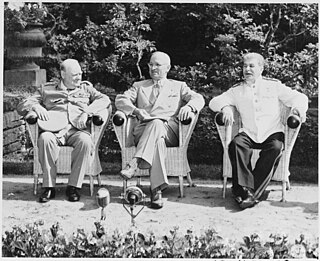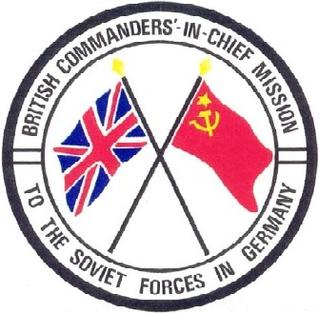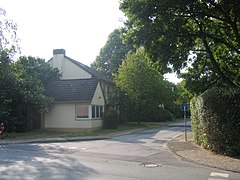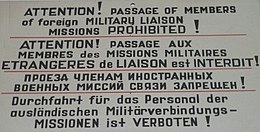
The Potsdam Conference was held at Potsdam in the Soviet occupation zone from July 17 to August 2, 1945, to allow the three leading Allies to plan the postwar peace, while avoiding the mistakes of the Paris Peace Conference of 1919. The participants were the Soviet Union, the United Kingdom, and the United States. They were represented respectively by General Secretary Joseph Stalin, Prime Ministers Winston Churchill and Clement Attlee, and President Harry S. Truman. They gathered to decide how to administer Germany, which had agreed to an unconditional surrender nine weeks earlier. The goals of the conference also included establishing the postwar order, solving issues on the peace treaty, and countering the effects of the war.

The Potsdam Agreement was the agreement among three of the Allies of World War II: the United Kingdom, the United States, and the Soviet Union after the war ended in Europe on 1 August 1945 and it was published the next day. A product of the Potsdam Conference, it concerned the military occupation and reconstruction of Germany, its border, and the entire European Theatre of War territory. It also addressed Germany's demilitarisation, reparations, the prosecution of war criminals and the mass expulsion of ethnic Germans from various parts of Europe. France was not invited to the conference but formally remained one of the powers occupying Germany.

The Bizone or Bizonia was the combination of the American and the British occupation zones on 1 January 1947 during the occupation of Germany after World War II. With the addition of the French occupation zone on 1 August 1948 the entity became the Trizone. Later, on 23 May 1949, the Trizone became the Federal Republic of Germany, commonly known as West Germany.
Following the termination of hostilities in World War II, the Allies were in control of the defeated Axis countries. Anticipating the defeat of Germany and Japan, they had already set up the European Advisory Commission and a proposed Far Eastern Advisory Commission to make recommendations for the post-war period. Accordingly, they managed their control of the defeated countries through Allied Commissions, often referred to as Allied Control Commissions (ACC), consisting of representatives of the major Allies.

Royal Air Force Gatow, or more commonly RAF Gatow, was a British Royal Air Force station in the district of Gatow in south-western Berlin, west of the Havel river, in the borough of Spandau. It was the home for the only known operational use of flying boats in central Europe, and was later used for photographic reconnaissance missions by de Havilland Canada DHC-1 Chipmunks over East Germany. Part of the former airfield is now called General Steinhoff-Kaserne, and is home to the Luftwaffenmuseum der Bundeswehr, the German Air Force Museum.

The Intelligence Corps is a corps of the British Army. It is responsible for gathering, analysing and disseminating military intelligence and also for counter-intelligence and security. The Director of the Intelligence Corps is a brigadier.

A military attaché or defence attaché is a military expert who is attached to a diplomatic mission, often an embassy. This type of attaché post is normally filled by a high-ranking military officer, who retains a commission while serving with a diplomatic mission. Opportunities sometimes arise for service in the field with military forces of another sovereign state. The attache has the privileges of a foreign diplomat.

The Glienicke Bridge is a bridge across the Havel River in Germany, connecting the Wannsee district of Berlin with the Brandenburg capital Potsdam. It is named after nearby Glienicke Palace. The current bridge, the fourth on the site, was completed in 1907, although major reconstruction was necessary after it was damaged during World War II.

The entirety of Germany was occupied and administered by the Allies of World War II from the Berlin Declaration on 5 June 1945 to the establishment of West Germany on 23 May 1949. Unlike occupied Japan, Germany was stripped of its sovereignty and former state: after Nazi Germany surrendered on 8 May 1945, four countries representing the Allies asserted joint authority and sovereignty through the Allied Control Council (ACC). At first, Allied-occupied Germany was defined as all territories of Germany before the 1938 Nazi annexation of Austria; the Potsdam Agreement on 2 August 1945 defined the new eastern German border by giving Poland and the Soviet Union all regions of Germany east of the Oder–Neisse line and divided the remaining "Germany as a whole" into four occupation zones, each administered by one of the Allies.

U.S. Army Berlin (USAB) was a command of the United States Army created in December 1961 at the height of the Berlin Wall crisis. USAB was a combined command with the Headquarters, U.S. Command Berlin (USCOB). This combined organization was sometimes called the "Berlin Command". USCOB/USAB was a separate command from the U.S. Army Europe (USAREUR) which had previously been in command of American troops in West Berlin.

The Berlin Brigade was a US Army brigade-sized garrison based in West Berlin during the Cold War. After the end of World War II, under the conditions of the Yalta and Potsdam agreements, the Allied forces occupied West Berlin. This occupation lasted throughout the Cold War. The French Army also had units in Berlin, called French Forces in Berlin and the British Army's unit in Berlin was the Berlin Infantry Brigade.

The British Commanders'-in-Chief Mission to the Soviet Forces in Germany (BRIXMIS) was a military liaison mission which operated behind the Iron Curtain in East Germany during the Cold War.

The Berlin Crisis of 1961 was the last major European political and military incident of the Cold War concerning the status of the German capital city, Berlin, and of post–World War II Germany. The crisis culminated in the city's de facto partition with the East German erection of the Berlin Wall.

The Allied Control Council (ACC) or Allied Control Authority, and also referred to as the Four Powers, was the governing body of the Allied occupation zones in Germany (1945–1949/1991) and Austria (1945–1955) after the end of World War II in Europe. After the defeat of the Nazis, Germany and Austria were occupied as two different areas, both by the same four Allies. Both were later divided into four zones by the 1 August 1945 Potsdam Agreement. Its members were the Soviet Union, the United Kingdom, the United States, and France. The organisation was based in Schöneberg, Berlin.
Arthur D. Nicholson Jr. was a United States Army military intelligence officer shot by a Soviet sentry while engaged in intelligence-gathering activities as part of an authorized military liaison mission which operated under reciprocal U.S.–Soviet authority. Military liaison missions were ostensibly liaisons between the British, French and U.S. forces and the Group of Soviet Forces in Germany, but they had a known intelligence-gathering secondary mission and an important role to verify that offensive action was not being prepared. Reciprocal groups were authorized and operated by both the British, French and U.S. and the Soviet Union during the Cold War. Nicholson is officially regarded by the U.S. Department of Defense as having been a victim of "murder" and the final "victim" of the Cold War. Nicholson's death led to a U.S. – Soviet crisis and intense negotiations regarding the military liaison missions.
Operation Osoaviakhim was a secret Soviet operation under which more than 2,500 former Nazi German specialists from companies and institutions relevant to military and economic policy in the Soviet occupation zone of Germany (SBZ) and Berlin, as well as around 4,000 more family members, totalling more than 6,000 people, were transported from former Nazi Germany as war reparations to the Soviet Union. It took place in the early morning hours of October 22, 1946 when MVD and Soviet Army units under the direction of the Soviet Military Administration in Germany (SMAD), headed by Ivan Serov, rounded up German scientists and transported them by rail to the USSR.

The French Forces in Berlin were the units of the French Armed Forces stationed since 1945 until the end of the Cold War-era in West Berlin according to the agreements of the Yalta Conference and Potsdam Conference. The troops were the French counterparts to the United States' Berlin Brigade and the United Kingdom's Berlin Infantry Brigade in the city.

The Berlin Infantry Brigade was a British Army brigade-sized garrison based in West Berlin during the Cold War. After the end of World War II, under the conditions of the Yalta and Potsdam agreements, the Allied forces occupied West Berlin. This occupation lasted throughout the Cold War. The French Army also had units in Berlin, called the French Forces in Berlin and the US Army's unit in Berlin was the Berlin Brigade.

The Allied Museum is a museum in Berlin. It documents the political history and the military commitments and roles of the Western Allies in Germany – particularly Berlin – between 1945 and 1994 and their contribution to liberty in Berlin during the Cold War era.

The British occupation zone in Germany was one of the Allied-occupied areas in Germany after World War II. The United Kingdom, along with the Commonwealth, was one of the three major Allied powers that defeated Nazi Germany. By 1945, the Allies had divided the country into four occupation zones: British, Soviet, American and French lasting until 1949, whence the new country of West Germany was established. Out of all the four zones, the British had the largest population and contained within it the heavy industry region, the Ruhr, as well as the naval ports and Germany's coast lines.



















